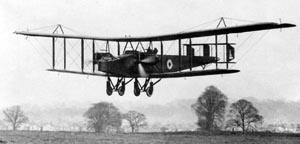The unique remains of a First World War Handley Page O/400 bomber aircraft have been saved by a team from the RAF Museum.
Members of the Michael Beetham Conservation Centre at the RAF Museum Cosford, have succeeded in rescuing a number of wing sections from a 95 year old bi-plane bomber which had been used to support a garage roof in Connah’s Quay, Flintshire. The 25 foot long wooden wing sections included four examples of the lower starboard wing and one lower port wing.
The RAF Museum was first alerted to the existence of the wings in April this year when an email was received suggesting that the roof of a building,which was due for demolition, had been constructed using wing components from a Second World War Wellington bomber. However, the Museum’s curatorial staff instantly recognised that the wings were from a much earlier aircraft.
Senior Curator Al McLean explained , “A visit to the site revealed that these were wooden wings with a type of construction known as box spars. This suggested that the aircraft dated from the latter part of the First World War and given the size of them, there were only a few aircraft types they could have originated from. The Handley Page O/400 was the obvious candidate and after a brief look at a manual we were fairly positive that that was what we were looking at.”
The RAF Museum discussed the identity of the wings with the site owner, Mr Alan Sullivan, and explained that they were even rarer than first thought. Mr Sullivan kindly allowed the Museum to remove the wings while the site was being cleared for development.
Originally ordered as an improved version of the Royal Naval Air Service’s O/100, the O/400 became the Royal Air Force’s standard heavy bomber during the closing months of the First World War. The giant twin-engined aircraft had a wing span of 100 feet and could attack targets up to 350 miles away with a payload of 16 112lb bombs or a single 1650lb bomb. From October 1918 O/400s undertook night raids against targets in Germany as part of the RAF’s Independent Air Force. After the war, O/400s continued in service as communication and transport aircraft until 1921 with the last RAF example retiring in 1923. Converted O/400s were also used by Handley Page Transport Ltd in their pioneering passenger service between London and Paris during the early 1920s.
RAF Museum Curator, Ewen Cameron said “The Handley Page O/400 is a vitally important aircraft in the history of the RAF. One of the main reasons the Royal Air Force was established in 1918 was so that it could operate as an independent arm of the military, capable of striking deep into the heart of enemy territory undermining that enemy’s strategic base and it was largely the O/400 which offered the RAF this capability”.
The O/400 wings were retrieved in October 2013 and moved into the Museum’s storage facility at RAF Stafford. Here the Museum houses other O/400 parts consisting of an outer panel from the upper wing, a number of interplane struts and a set of elevators, all believed to be the only known examples in the world. For further information, please visit the Royal Air Force Museum websitewww.rafmuseum.org
